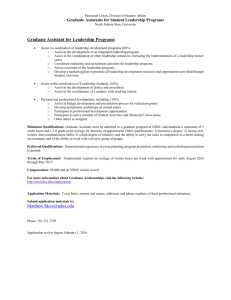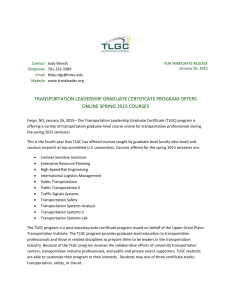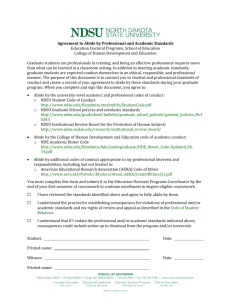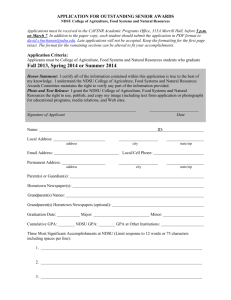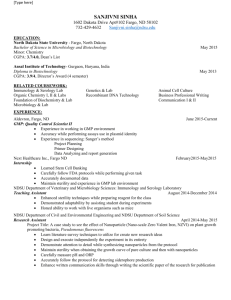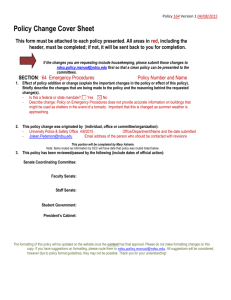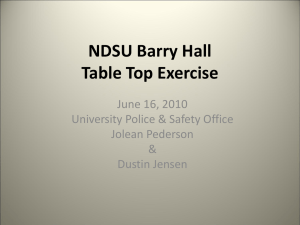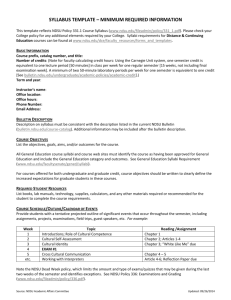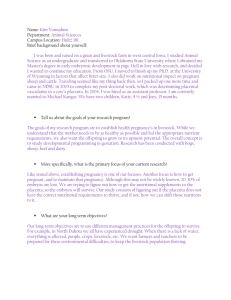Research Task Force Report and Charge
advertisement
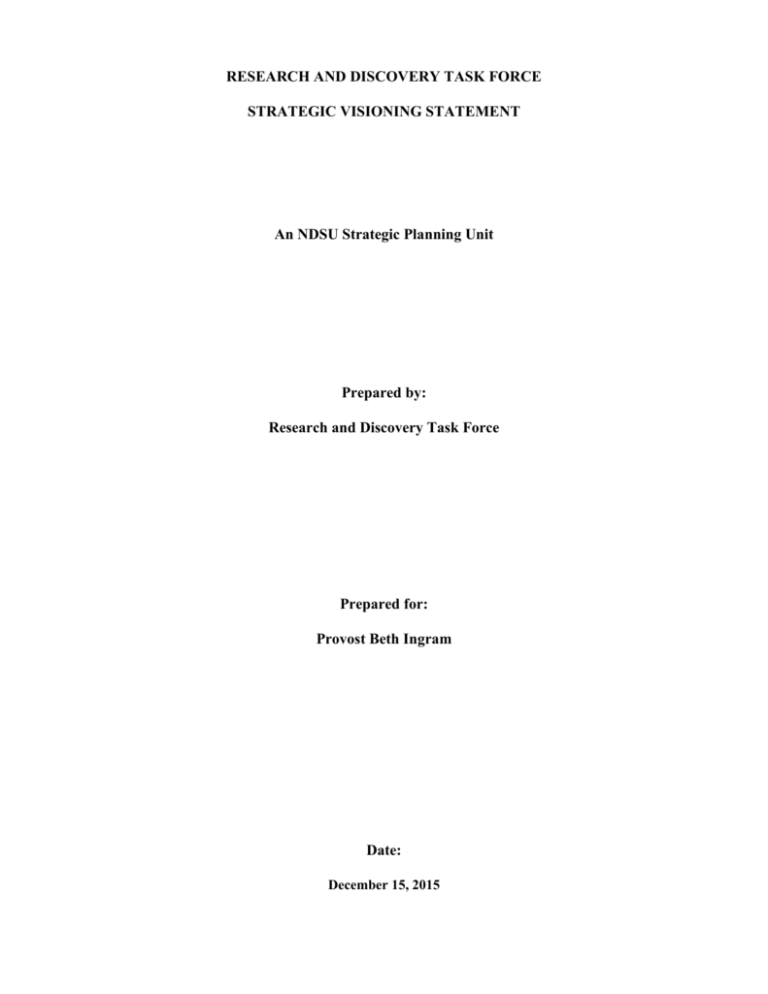
RESEARCH AND DISCOVERY TASK FORCE STRATEGIC VISIONING STATEMENT An NDSU Strategic Planning Unit Prepared by: Research and Discovery Task Force Prepared for: Provost Beth Ingram Date: December 15, 2015 Research and Discovery Task Force Members Co-Chairs Kelly A. Rusch, Ph.D., P.E. – Vice President, Research and Creative Activity Don Warne – M.D., MPH – Director, Master of Public Health Program Members Chuck Hoge – Interim Executive Director, Research and Technology Park Kalpana Katti, Ph.D. – University Distinguished Professor, Civil and Environmental Engineering Jeffrey Clark, Ph.D. – Professor and Chair, Sociology and Anthropology Larry Reynolds, Ph.D., University Distinguished Professor, Animal Science Kyle Hackney, Ph.D., CSCS, CISSN – Assistant Professor, Health, Nutrition and Exercise Science Mark McCourt, Ph.D. – Director, Center for Visual and Cognitive Neuroscience; Dale Hogoboom and James A. Meier Professor of Psychology Denver Tolliver, Ph.D. – Director, Upper Great Plains Transportation Institute ii North Dakota State University (NDSU) Strategic Visioning Statement NDSU is dedicated to transforming the lives of North Dakotans through research and discovery, thus, insuring for the state a highly educated population that: Enjoys a high quality of life, Understands the ways the natural and social worlds work, and Appreciates the impact of technology and science in the everyday lives of our citizens. Research and Discovery Vision at NDSU [and inclusive of creative activity and innovation] The research and discovery vision at NDSU is focused on achieving national and international recognition as a premier public Research University, committed to solving complex and evolving Grand Challenges in the areas of: Food Systems and Security, Healthy Populations and Vital Communities, and Sustainable Energy, Environment, and Societal Infrastructure. The proposed Research and Discovery Vision centers on three Grand Challenges, which leverage current and emerging strengths of NDSU researchers and align the university with the needs of the state, the nation, and the world. In parallel, this vision encapsulates the environmental, human (health, social, cultural) and technological aspects of challenges that are global in nature and must be addressed in this century as the world’s growing population continues to put tremendous pressures on food, health, environmental, and societal infrastructure. These research and discovery themes are multiple disciplinary [defined as multidisciplinary, interdisciplinary and/or transdisciplinary] in nature and are to be fully integrated across the research, education, and outreach missions of the university. They will provide a spectrum of opportunity for full engagement of persons across engineering, health, basic and social sciences, agriculture, arts and humanities. The themes look inward to the strength of the campus community while simultaneously positioning the university to increase and accelerate outward economic development and outreach across the State. NDSU’s Research and Discovery Vision will be achieved by meeting the following goals: Propel the research and discovery enterprise forward, providing economic stimulus and creating employment opportunities across the state. Attract and retain: - High quality faculty and staff, - Students who will fill the needs of employers today and in the future. Establish and maintain - Sustainable funding, - Long-term partnerships with private and government entities. Achieve status as a top 50 public research university. It is recognized that achieving NDSU’s Research and Discovery Vision will be challenging and require: A cultural shift across the entire institutional enterprise. 1 A dedication to hard work to achieve the magnitude of change outlined in this document. A Peer Benchmarking effort to ensure initiatives are in line with national norms. A budget model process and financial commitment over the next five to ten years that recognizes the growing research and discovery enterprise. Strategies and Actions to Accomplish the Vision Eight strategies (and accompanying actions and/or initiatives) support the vision/goals and are predicated on the availability of significant new resources and/or internal redistribution of existing resources, primarily via incentivized funding programs, to support the growth of capacity to meet the Grand Challenges. While other areas of research are important, the elevation of NDSU to national and international prominence requires focused investment on our strengths and a funding model that follows the strategic vision. 1. Developing a committed, focused, and coordinated effort toward research and discovery excellence: A concerted, organized, and clearly articulated focus on the research enterprise – a shared vision that is consistent and permeates all levels of the faculty, staff, and administration. The focus should be coordinated and led by the Vice President for Research and Creative Activity (VPRCA); this will require real, programmatic funds controlled and administered by that office. A focused, integrated, and coordinated approach between the VPRCA and the Graduate Dean. Expanded and coordinated activities between University Relations and the VPRCA that provide: - Mechanism(s) to clearly articulate the impact of a leading, public research university on the state, region, nation, and world. - Mechanism(s) to clearly articulate the research vision of the university. A Research Foundation highly coordinated with the RCA office and actively involved in the support of high-potential research activities. A Development Foundation highly engaged with the RCA office and actively involved in the support of high-potential industrial- and foundation-sponsored research activities. A focused effort to transform the Research and Technology Park model (currently a real estate model) into one of an Innovation Campus (with facilities and programming), resulting in an intentional and engaging environment for collaborative faculty, student, and business innovation. 2. Creating and developing the human infrastructure needed to find solutions to the Grand Challenges consistent with the 18x18 TARGET– 18,000 students by 2018 [mean 18:1 student:faculty ratio] Create a strategic marketing/recruitment plan to grow undergraduate and graduate student numbers in disciplines that support the efforts to meet the Grand Challenges. Target an undergraduate:graduate student ratio of 75%:25%. Target a faculty [tenured/tenure-track] increase to 900-1,000 to meet the 18:1 student:faculty ratio. Strategic [competition-based] faculty cluster hires that contribute to a minimum of at least one Grand Challenge. Strategic analysis and growth of support staff to enable the growth of the academic enterprise. Develop a plan to increase and support nontraditional research staff (research faculty, post-docs). Review policies and criteria governing Research Faculty, Professors of Practice, Graduate Faculty status and Professor Emeriti for alignment with expectations of a growing research and discovery enterprise. Ensure Developmental Leave policy is aligned with the Research and Discovery Vision. Develop programs and provide funds for efforts aimed at cultivating future leaders via the creation of an Academic Fellows Program. Create a centralized graduate student career center focused on skillset development, professional development, communications development, etc. 2 Create a “communicating across the curriculum and research enterprise” effort to help develop the written, oral, visual, and technological skillsets of students. Establish an Endowed Chair/Professorship program (private:public funding) to reward “excellence” across research, education, and outreach areas relevant to the Grand Challenges. Establish a Ph.D. Fellowship Program to attract the best students into areas relevant to the Grand Challenges. 3. Providing 21st century learning, research, and discovery environments to enhance new knowledge development around the Grand Challenges: Coordinated, university-wide plan for physical infrastructure to support collaborative innovation, research, and discovery enterprise. “Library of the future” that can meet the needs of the research and discovery enterprise as well as education and outreach, in an integrated and innovative academic setting. CORE Labs – careful review of current labs, the criteria for new CORE facilities, and compilation of a plan for sustainable operation and maintenance of such facilities. High Performance and Advanced Computing/Informatics/data visualization – this is a requirement for excellence in numerous areas of research; includes ease of access to universitysupported computing services. 4. Providing streamlined decision making that integrates processes at all levels Review the current organizational structure to ensure alignment and efficiency of service for a growing research university. Perform a systematic review of policies/procedures that impact research and discovery to ensure alignment with growth of the enterprise. Streamline processes to enable a reduced timeline for hiring soft-money personnel on grants. Streamline and incentivize the intellectual property and patent process. Increase the efficiency of the pre-award and compliance processes through migration to electronic research administration. Streamline and incentivize faculty start-ups. Streamline decision making process for pooled funds [e.g., equipment match] that impact research/proposals and integrate these into RCA to provide a centralized point of contact. Align the PTE policy/process with the evolving research and discovery enterprise. 5. Providing excellence in research and discovery at all levels that results in solutions for the Grand Challenges Create research development programs that increase the success of large, multiple disciplinary teams: - Invest in the growth of the Research Development Office in RCA - Invest in multiple disciplinary NDSU seed grant programs - Invest in “Center/Large-initiative” development grant programs Invest in an NDSU Federal Relations person who is immersed daily in building stronger relationships with federal agencies and keeping up-to-date on congressional activities and funding directions. Establish an undergraduate research unit within RCA to provide institution-wide coordination of undergraduate research opportunities and funding. Develop a coordinated approach for multiple disciplinary graduate and undergraduate courses/programs that promote innovation, entrepreneurship, and collaboration that dovetail with the Grand Challenges. Develop incentivized programs to integrate the STEM disciplines with the arts and humanities, where appropriate. 3 Place a concerted effort on attracting superior Ph.D. students into multiple disciplinary graduate programs by providing competitive stipends and benefits. 6. Helping North Dakota’s economy through innovation Expand the support for the Business Development unit in RCA to provide one-stop shopping of services for companies looking to partner with NDSU and for communicating the strengths and capabilities of the NDSU community to potential companies. Expand support for entrepreneur and innovation programming utilizing the College of Business and better integrate the Research and Technology Programs into campus. 7. Elevating the profile of the NDSU Research and Discovery Enterprise Create focused communications to NDSU stakeholders regarding the economic impact and opportunities the research and discovery enterprise has and offers. Establish a President’s (or Provost’s) Lectureship Series to bring key national and international leaders, both public and private, to campus to interact with faculty, staff and students. Evaluate and create or enhance unit- and university-level communication avenues (web presence, face-to-face, video, print, etc.) to effectively articulate NDSU’s Research Vision and its impact. Expand support for a concerted effort/unit responsible for promoting or nominating faculty, staff, and students for national awards and committee memberships. 8. Diversifying the research revenue streams Better position the university as an economic partner in the state, which will lead to better public:private partnerships. Increase engagement of alumni, foundations, and industry donors to enhance research funding. Develop new revenue streams; professional [defined as focused on working professionals] master’s degrees relevant to the state. Establish a concerted effort focused on interactions with the various national labs. Financing the Research and Discovery Enterprise The Task Force recognizes that a complete action plan has not been developed to guide a “refined” financing of the Research and Discovery Vision. There are, however, several foundational actions that are needed to ensure the future of the research and discovery enterprise. This is an investment in North Dakota that will result in research and products (physical and human) to attract businesses to the State: 1. Permanent Research Fund focused on quality and quantity of physical and equipment infrastructure. 2. Identified and permanent source of funds to increase faculty size to align with an 18:1 student:faculty ratio under the 18x18 target model (and subsequent increase in proportional support staff). 3. Endowed Professorship/Chair Fund –private:state. 4. Graduate Fellowships aimed at high-needs areas within the state and consistent with the Vision. 5. Fund RCA to fully support research and discovery efforts on campus. 6. Incentivize via distribution of internal discretionary funds through RCA; on a competitive basis and in support of the Grand Challenges. - Start-up funds competitive with our peer institutions and move to a consistent model of responsibility for start-up funds (i.e., percentage from dept., college, RCA) - Seed and bridging grant programs - Pooled funding for cluster hires [grouping of faculty lines] in support of the Grand Challenges - Dedicated fund for equipment service contracts, upgrades, replacement, and purchase - Increased graduate stipend/health care support - Undergraduate research internship program funds - Faculty and graduate student Travel Award Program – internal matching program 4 Recommendation for a living Strategic Plan The Task Force believes that an ongoing review of the Research and Discovery Visioning Statement via a standing Planning Committee is necessary for NDSU to elevate its Research and Discovery Profile. 1. 2. 3. 4. Accept the Vision/Goals stated on page 1. Accept the Strategies stated on pages 2-4. Develop yearly, prioritized actions for each Strategy (a foundational list is provided for review). Establish metrics/targets to assess success of actions associated with each Strategy in support of the Goals – yearly review. This review also assesses the return on investment of the provided funding. 5
